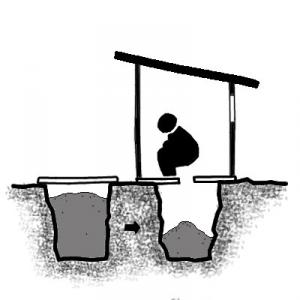Executive Summary
The Fossa Alterna is a short cycle alternating, waterless (dry) double pit technology. Compared to the double VIP which is just designed to collect, store and partially treat excreta, the Fossa Alterna is designed to make an earth-like product that can be used as a nutrient-rich soil conditioner. The Fossa Alterna is dug to a maximum depth of 1.5 m and requires a constant input of cover material (soil, ash, and/or leaves).
| In | Out |
|---|---|
Faeces, Excreta, Organics, Dry Cleansing Materials, Anal Cleansing Water |
Compost/Biosolids |
The fossa alterna toilet system is similar to the Arborloo, but it consists of two pits, which are lined.
[no-ecompendium]Treatment Process[/no-ecompendium]
Cover material (soil, ash, and/or leaves) should be added to the pit after defecation (not urination). The soil and leaves introduce a variety of organisms like worms, fungi and bacteria which help in the degradation process. Also, the pore space is increased, which allows for aerobic conditions. Additionally, ash helps to control flies, reduces odours and makes the mix slightly more alkaline.
The full pit degrades while the second pit is filling, which, ideally, should take one year. The material in the full pit will degrade into a dry, earth-like mixture (see also composting at small scale) that can be easily removed manually and introduced into agriculture (see also use of urine and faeces in agriculture) . Because of the added carbonaceous bulking material, the degradation process is accelerated, and the content is ready for excavation and use much faster than in a double VIP.
Design Considerations
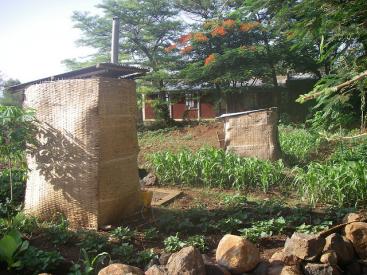
A Fossa Alterna pit would fill over a period of 12–24 months depending on its size and the number of users. Even though the pits are shallow (1 to 1.5 m), each of them can be used by a family of six for one year. The Fossa Alterna technology will only work properly if the two pits are used sequentially and not concurrently. Therefore, an adequate cover for the out of service pit is required.
The Fossa Alterna should be used for urine (if urine not collected separately) , but water should not be added (small amounts of anal cleansing water can be tolerated). Water encourages the development of vectors and pathogens, but it also fills the pore spaces and deprives the aerobic bacteria of the oxygen that is required for degradation. A UDDT can be used with the Fossa Alterna, but only in circumstances when the soil cannot sufficiently absorb the urine or when the urine is highly valued for application. Since cover material is used to continuously cover the excreta, smells are reduced. To reduce the smells even further, a ventilation pipe can be added.
In flood-prone areas and where the groundwater table is too high, the Fossa Alterna could be raised or built entirely above ground to avoid water intrusion and groundwater pollution. Raising the pits could also be an option for rocky ground and compacted soils that are difficult to dig.
If space is abundant and emptying not desired, the Arborloo can be an alternative disposal option. Pits should not be lined if used as an Arborloo.
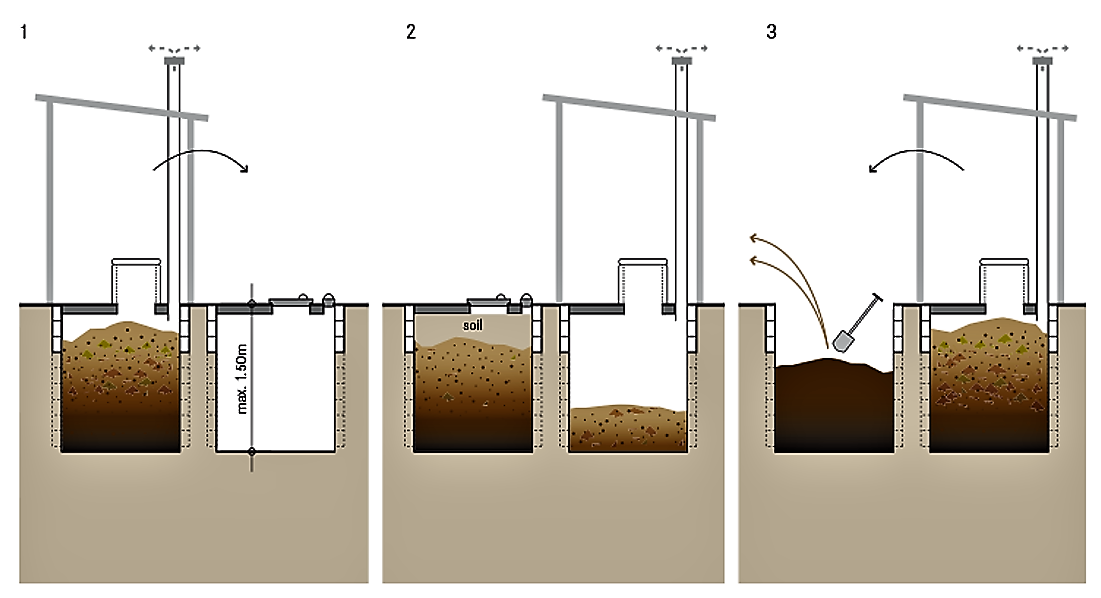
[no-ecompendium]Cost Considerations[/no-ecompendium]
The costs for Fossa Alterna toilet systems are relatively low. Compared to a simple pit latrine or the arborloo, the initial costs may be somewhat higher, as two pits have to be dug and lined. However, they are less deep than common pit toilets. Furthermore, the Fossa Alterna can be used over and over again, which makes them a very economic alternative in the long run. Also, compost is produced, which can generate additional income.
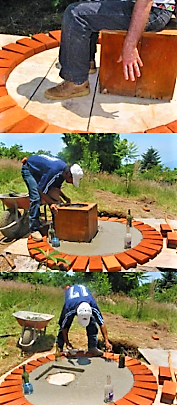
Health Aspects/Acceptance
By covering faeces with soil, ash, and/or leaves, flies and odours are kept to a minimum. Users may not understand the difference between the Fossa Alterna and a double VIP, although if given the opportunity to use one, people should have a good appreciation of the advantages. Demonstration units can be used to show how easily one can empty a Fossa Alterna in comparison to emptying a double pit. Keeping the contents sealed in the pit for the duration of at least one year makes the material safer and easier to handle. The same precautions that are taken when handling compost should be taken with the humus derived from the Fossa Alterna.
Operation & Maintenance
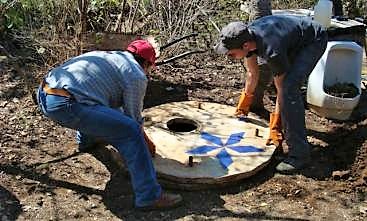
When the first pit is put into use, a layer of leaves should be put onto the bottom of the pit. Periodically, more leaves should be added to increase the porosity and oxygen availability. Following the addition of faeces to the pit, a small amount of soil, ash, and/or leaves should be added. Occasionally, the mounded material beneath the toilet hole should be pushed to the sides of the pit in order to optimise the use of space.
Unlike a simple or ventilated pit which will be covered or emptied, the material in the Fossa Alterna is meant to be used as a soil conditioner. Therefore, it is extremely important that no garbage is put into the pit.
Emptying the Fossa Alterna is easier than emptying other pits; the pits are shallower and the addition of soil, ash, and/or leaves means that the contents are less compact. The material that is removed is not offensive and presents a reduced threat of contamination. Depending on the dimensions of the pits, the contents should not be emptied more often than once a year.
[no-ecompendium]At a Glance
| Working Principle | The fossa alterna consists of two partially lined pits and is designed to make compost, which can be used in agriculture to improve soil quality. The fossa alterna requires a constant input of soil. One of the pits is used at a time. When the first pit is filled up it is closed and the other pit is put in use |
| Capacity/Adequacy | The fossa alterna is designed for rural and peri-urban areas. It is simple to build and can be constructed by the user itself with locally available material. |
| Performance | The decomposition of the faecal material is going well as long as dry material is added and water inlet is prevented |
| Costs | Low-cost |
| Self-help Compatibility | Can be built and repaired with locally available material. It must be maintained correctly (instruction by an expert). |
| O&M | The fossa alterna requires the frequent addition of dry material (soil, leaves, ash). |
| Reliability | If well maintained and constructed, high. |
| Main strength | No water required; Produces humanure. |
| Main weakness | Requires large amount of dry material. Not suitable with a high groundwater table. |
The Fossa Alterna is appropriate for rural and peri-urban areas. It is especially suitable to water-scarce environments. It is a useful solution for areas that have poor soil and could benefit from the use of the stabilized humic material as a soil amendment.
The Fossa Alterna is not appropriate for greywater as the pit is shallow and the conditions must remain aerobic for degradation.
The material is manually emptied from the Fossa Alterna (it is dug out, not pumped out); thus, vacuum truck access to the pits is not necessary.
The Fossa Alterna is not suited for rocky or compacted soils (that are difficult to dig) or for areas that flood frequently or which have a high groundwater table as the pit is shallow and the conditions must remain aerobic for degradation and groundwater protected from pollution , except if the pits are raised.
A urine diversion toilet slab can be used with the fossa alterna if the soil cannot sufficiently absorb the urine or urine is needed for agriculture (see also application of urine (small scale)).
The Fossa Alterna technology will only work properly if the two pits are used sequentially and not concurrently. Therefore, an adequate cover for the out of service pit is required
Toilets That Make Compost
This book describes in an easy-to-understand and picture-based way how to construct three different low cost sanitation solutions, namely arborloos, fossa alterna and urine diversion toilets.
MORGAN, P. EcoSanRes (2007): Toilets That Make Compost . Stockholm: Stockholm Environment Institute URL [Accessed: 09.05.2019]Ecological Toilets
This book describes how to construct Arborloo toilets and how it can be upgraded to VIPs at a later stage.
MORGAN, P. EcoSanRes (2009): Ecological Toilets. (pdf presentation). Stockholm: Stockholm Environment Institute URL [Accessed: 09.05.2019]Fossa alterna
Fossa alterna with a urine diversion component (optional). Image from Flickr
Compendium of Sanitation Systems and Technologies
This compendium gives a systematic overview on different sanitation systems and technologies and describes a wide range of available low-cost sanitation technologies.
TILLEY, E., LUETHI, C., MOREL, A., ZURBRUEGG, C. and SCHERTENLEIB, R. (2008): Compendium of Sanitation Systems and Technologies. Duebendorf, Switzerland: Swiss Federal Institute of Aquatic Science and Technology (EAWAG) and Water Supply and Sanitation Collaborative Council (WSSCC) URL [Accessed: 15.02.2010] PDFCompendium of Sanitation Systems and Technologies. 2nd Revised Edition
This compendium gives a systematic overview on different sanitation systems and technologies and describes a wide range of available low-cost sanitation technologies.
TILLEY, E., ULRICH L., LÜTHI, C., REYMOND P. and ZURBRÜGG C. (2014): Compendium of Sanitation Systems and Technologies. 2nd Revised Edition. Duebendorf, Switzerland: Swiss Federal Institute of Aquatic Science and Technology (Eawag) URL [Accessed: 03.05.2023] PDFCompendium of Sanitation Systems and Technologies (Arabic)
This is the Arabic version of the Compendium of Sanitation Systems and Technologies. The Compendium gives a systematic overview on different sanitation systems and technologies and describes a wide range of available low-cost sanitation technologies.
TILLEY, E. ULRICH, L. LUETHI, C. REYMOND, P. SCHERTENLEIB, R. ZURBRUEGG, C. (2014): Compendium of Sanitation Systems and Technologies (Arabic). 2nd Revised Edition. Duebendorf, Switzerland: Swiss Federal Institute of Aquatic Science and Technology (Eawag) PDFToilets That Make Compost. Factsheet
This information sheet summarises the Peter Morgan publication under the same name on two pages. It describes three types of simple and affordable composting toilets: Two types of shallow pit toilets (arborloo) and the urine diverting toilet.
EcoSanRes (2008): Toilets That Make Compost. Factsheet. (pdf presentation). (= EcoSanRes Factsheet 13 ). Stockholm: Stockholm Environment InstituteClosing the loop – Ecological Sanitation for food security
This document was compiled during an international, interdisciplinary workshop in Mexico. This manuscript increases the understanding of how to develop more sustainable sanitation systems, particularly in urban/peri-urban contexts, while contributing to food production and improved nutrition.
ESREY, S.A. ANDERSSON, I. HILLERS, A. SAWYER, R. (2001): Closing the loop – Ecological Sanitation for food security. Stockholm: Swedish International Development Cooperation Agency URL [Accessed: 24.11.2010]The Value of Leaves as and Additive of Fossa Alterna Pits
This is a short description and findings of a trial adding leaves to fossa alterna pits. Leaves help the composting process considerably, by adding more air into the mix, and by adding a composting process undertaken largely by fungi to the already existing bacteriological process undertaken by soil micro-organisms.
MORGAN, P. (2004): The Value of Leaves as and Additive of Fossa Alterna Pits. Stockholm : Ecological Sanitation Research (EcoSanRes), Stockholm Environment Institute (SEI) URL [Accessed: 21.06.2013]The Toilet That Makes Humus
This easily understandable presentation deals with making humus in shallow pits by means of the Fossa alterna. Foci are set on: - How the Fossa alterna works (in Zimbabwe, Mozambique, Malawi) - Stages of construction - Routine management - Changing pits - Potential problems - Hand washing devices - Humus from the Fossa alterna - Enhanced growth of vegetables with “Fossa humus”
MORGAN, P. (2004): The Toilet That Makes Humus. An Account of the Fossa Alterna System and its Usefulness in Rural and Peri-Urban Communities. Stockholm : Ecological Sanitation Research (EcoSanRes), Stockholm Environment Institute (SEI) URL [Accessed: 20.06.2013]Plant Trials Using Fossa Alterna Humus
The ultimate proof of the usefulness of eco-humus and urine in agriculture is to demonstrate its effect on plant growth and yield directly. This chapter describes a series of trials in which the growth and yield of vegetables planted in humus derived from the Fossa alterna were studied.
MORGAN, P. (2004): Plant Trials Using Fossa Alterna Humus. Stockholm : Ecological Sanitation Research (EcoSanRes), Stockholm Environment Institute (SEI) URL [Accessed: 20.06.2013]Toilets That Make Compost
This book describes in an easy-to-understand and picture-based way how to construct three different low cost sanitation solutions, namely arborloos, fossa alterna and urine diversion toilets.
MORGAN, P. EcoSanRes (2007): Toilets That Make Compost . Stockholm: Stockholm Environment Institute URL [Accessed: 09.05.2019]Ecological Toilets
This book describes how to construct Arborloo toilets and how it can be upgraded to VIPs at a later stage.
MORGAN, P. EcoSanRes (2009): Ecological Toilets. (pdf presentation). Stockholm: Stockholm Environment Institute URL [Accessed: 09.05.2019]Ecodesign: The Bottom Line
There is no single design solution to sanitation. But there are universal principles for systematically and safely detoxifying human excreta, without contaminating, wasting or even using water. Ecological sanitation design — which is focused on sustainability through reuse and recycling — offers workable solutions that are gaining footholds around the world, as Nature explores on the following pages through the work of Peter Morgan in Zimbabwe, Ralf Otterpohl and his team in Germany, Shunmuga Paramasivan in India, and Ed Harrington and his colleagues in California.
NATURE (Editor) ; MORGAN, P. ; OTTERPOHL, R. ; PARAMASIVAN, S. ; HARRINGTON, E. (2012): Ecodesign: The Bottom Line. In: Nature: International Weekly Journal of Science: Volume 486 , 186-189. URL [Accessed: 19.06.2012]How to Manage Public Toilets and Showers
The purpose of this decision-making aid is to provide practical advice and recommendations for managing toilet blocks situated in public places. It is primarily aimed at local decision-makers in developing countries and at their partners (project planners and managers).
TOUBKISS, J. (2010): How to Manage Public Toilets and Showers. (= Six Methodological Guides for a Water and Sanitation Services' Development Strategy , 5 ). Cotonou and Paris: Partenariat pour le Développement Municipal (PDM) and Programme Solidarité Eau (pS-Eau) URL [Accessed: 19.10.2011]Ecological Sanitation - revised and enlarged edition
This book is one of the most fundamental and important books that defined the concept of ecological sanitation. The first version came out in 1998 - this version presents the findings of over ten years of research and development in ecological sanitation supported by SIDA (Swedish International Development Cooperation Agency).
WINBLAD, U. SIMPSON-HERBERT, M. (2004): Ecological Sanitation - revised and enlarged edition. (pdf presentation). Sweden: Stockholm Environment Institute URL [Accessed: 04.08.2010]Introducing Ecological Sanitation in Northern Mozambique
This is a fieldwork report about introducing ecological sanitation in northern Mozambique.
BRESLIN, E.D. (n.y): Introducing Ecological Sanitation in Northern Mozambique. London: Water Aid URL [Accessed: 25.11.2001]Experiments with Ecological Sanitation and Pit Emptying in Maputaland, South Africa
This document describes the experimental design of ecological sanitation and pit-emptying trials in Maputaland, South Africa. It describes the situation found at field visits in 2000 and 2003.
MORGAN, P. (2003): Experiments with Ecological Sanitation and Pit Emptying in Maputaland, South Africa. A Description of Visits Made in 2000 and 2003. Stockholm : Ecological Sanitation Research (EcoSanRes), Stockholm Environment Institute (SEI) URL [Accessed: 20.06.2013]Ecological Sanitation in Southern Africa
This document describes the ecological sanitation situation in South Africa, focussing on the range of technological options, promotional methods and recycling methods and the problem areas.
MORGAN, P. (2005): Ecological Sanitation in Southern Africa. Many Approaches to a Varied Need. Stockholm : Ecological Sanitation Research (EcoSanRes), Stockholm Environment Institute (SEI) URL [Accessed: 21.06.2013]Available Sanitation Technologies for Rural and Peri-Urban Africa
The presentation allows for a good overview on existing types of pit latrines in Africa, but also on other types of sanitation technologies such as the conventional flush toilet, the pour flush toilet, and the urine diversion dehydration toilet (UDDT).
MORGAN, P. (2007): Available Sanitation Technologies for Rural and Peri-Urban Africa. Stockholm : Ecological Sanitation Research (EcoSanRes), Stockholm Environment Institute (SEI) URL [Accessed: 20.06.2013]Lessons from a Low Cost Ecological Approach to Sanitation in Malawi
Low cost Ecological Sanitation programs in Malawi have led to the building of over 11,000 compost-producing toilets since 2003. While the toilets are affordable and simple to construct, the fact that they convert human waste into valuable odour-free compost, enables cost recovery for households and is a prime driver in popularizing EcoSan designs. This field note summarizes the lessons learned thus far in Malawi’s efforts to popularize ecological sanitation.
MORGAN, P. (2007): Lessons from a Low Cost Ecological Approach to Sanitation in Malawi. Washington: Water and Sanitation Program (WSP) URL [Accessed: 20.06.2013]Introducing Low Cost Productive Sanitation in a Peri-Urban Settlement
The following presentation deals with low cost ecological toilets (Fossa alterna) which were introduced at Hopley Farm, a settlement close to Harare, Zimbabwe. The presentation addresses the following topics: - How the alternating shallow pit system works - Local agricultural practice - Linking sanitation to agriculture - Testing for effect of urine - Linking sanitation to forestry
MORGAN, P. (2010): Introducing Low Cost Productive Sanitation in a Peri-Urban Settlement. Stockholm : Ecological Sanitation Research (EcoSanRes), Stockholm Environment Institute (SEI) URL [Accessed: 20.06.2013]Ecological Sanitation in Malawi
This illustrative presentation on ecological sanitation in Malawi, focuses on the concept of ecological sanitation, types of eco-toilets and basic methods of recycling nutrient from human excreta.
MORGAN, P. (2010): Ecological Sanitation in Malawi. Stockholm : Ecological Sanitation Research (EcoSanRes), Stockholm Environment Institute (SEI) URL [Accessed: 31.05.2019]The ROSA Project
The ROSA project stands for Resource-Oriented Sanitation concepts for peri-urban areas in Africa. This Sustainable Sanitation Practice (SSP) issue contains the following contributions: 1. Introduction to the ROSA Project, 2. From Pilot Units to Large-Scale Implementation - Ethiopia, 3. Implementation of UDDTs at Schools - Kenya, 4. Urban Agriculture for Sanitation Promotion, 5. Operation an Maintenance in Practice, 6. Experiences from Strategic Sanitation Planning, 7. Main Findings and Main Achievements.
MUELLEGGER, E. ; LANGEGRABER, G. ; LECHNER, M. (2010): The ROSA Project. (= Sustainable Sanitation Practice , 4 ). Vienna: Ecosan Club URL [Accessed: 01.07.2013]Fossa Alterna for Household Sanitation
Case study about fossa alterna toilets for household sanitation in Arba Minch, Ethiopia.
SHEWA, W.A. SuSanA (2009): Fossa Alterna for Household Sanitation. Arba Minch, Ethiopia: Sustainable Sanitation Alliance (SuSanA) URL [Accessed: 25.11.2010]An Ecological Approach to Sanitation in Uganda using Arborloo and Fossa Alterna
This paper gives an overview on arborloo and fossa alterna technologies referring to existing projects in Africa.
SMET, J. ACHIRO, B. MOMMEN, B. TURYAREEBA, P. LeaPPS (2008): An Ecological Approach to Sanitation in Uganda using Arborloo and Fossa Alterna. LeaPPS Case. Uganda: Learning for Practice and Policy on Household and School Sanitation and Hygiene (LeaPPS)Facility Design and Use of a Fossa Alterna Toilet
This poster illustrates the single steps and use of a Fossa Alterna toilet.
NETWAS (n.y): Facility Design and Use of a Fossa Alterna Toilet. Kampala: Network for Water and Sanitation (NETWAS) URL [Accessed: 29.09.2011]Proper Use and Safe Handling of Ecosan By-Products
This poster illustrates how to use Ecosan toilets and handle faecal compost in a safe way.
NETWAS (n.y): Proper Use and Safe Handling of Ecosan By-Products. Kampala: Network for Water and Sanitation (NETWAS) URL [Accessed: 11.05.2019]Primary and Secondary Processing of Ecosan By-Products
This poster illustrates how to transform faecal waste to usable compost.
NETWAS (n.y): Primary and Secondary Processing of Ecosan By-Products. Kampala: Network for Water and Sanitation (NETWAS) URL [Accessed: 11.05.2019]http://aquamor.tripod.com
This website contains all important information about the fossa alterna, written by Peter Morgan.

